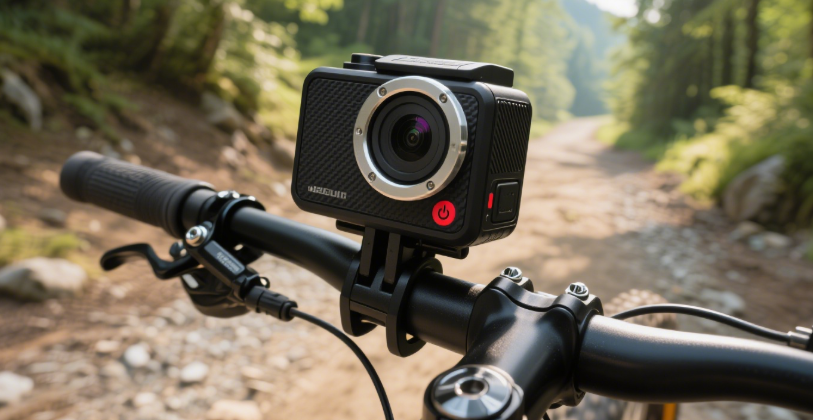Why are mountain bike cameras so popular?
The popularity of mountain bike cameras stems primarily from their ability to meet the needs of mountain bike enthusiasts for documenting, sharing, and enhancing their riding experiences, while also adapting to the unique environment and culture of mountain biking.
1. Capturing Thrilling Moments
Documenting Adventure: Mountain biking is full of high-speed descents, jumps, and challenging terrain. Cameras (such as the GoPro Hero12 Black) can capture these thrilling moments in high resolution (such as 4K/5.3K) and slow motion (120-240fps), allowing riders to relive or share their adrenaline rush.
Immersive Experience: Helmets or chest mounts (such as the GoPro Max or Insta360 X3) offer a first-person perspective (POV), placing viewers right in the middle of the action and enhancing their sense of immersion, making them popular with social media users.
2. Sharing and Social Media Distribution
Content Creation: The mountain bike community is active on platforms like YouTube and Instagram, and cameras make it easy for riders to create high-quality videos showcasing tricks, scenery, or adventures. For example, the GoPro Hero11 Black automatically uploads videos to the cloud and generates curated videos for easy sharing.
Social Showoff: Capturing spectacular descents or jumps boosts a rider's social capital, attracting attention and interaction, driving the popularity of cameras.

3. Improving Cycling Techniques and Learning
Technical Analysis: POV videos recorded by cameras help riders analyze their line choices, posture, and cornering technique. For example, coaches can use videos to point out areas for improvement, which is more intuitive and effective than verbal advice.
Learning New Routes: Riders can preview unfamiliar routes by watching other riders' videos, understanding the terrain and obstacles, and improving safety and performance.
What are the key things to avoid when buying a camera for mountain biking?
When buying a camera for mountain biking, there are key things to consider to avoid potential pitfalls. Make sure you choose a waterproof video camera that's suitable for mountain biking, taking into account performance, budget, and durability.
1. Avoid cameras that aren't durable
Issue: Mountain biking is a harsh environment involving vibrations, mud, rain, and impacts, making ordinary cameras or low-quality action cameras easily damaged.
Tips for avoiding lightning:
Choose a camera that's waterproof, dustproof, and shockproof. Check its IP rating (such as IPX8) or whether it comes with a waterproof housing.
Prioritize reputable brands (such as Akaso and GoPro) and avoid cheap knockoffs, which can damage the lens or sensor due to vibrations.
Check user reviews to ensure the camera's reliability in rugged terrain. For example, the Akaso Brave 7 LE is highly rated by budget users for its waterproof housing and durability.
2. Don't overlook image stabilization
Problem: Mountain biking can be extremely shaky. Cameras lacking image stabilization can produce blurry or choppy videos, affecting the viewing experience.
Avoidance Tip: Choose a camera with advanced image stabilization technology. Test or consult reviews to ensure that stabilization remains effective even when descenting at high speeds or on bumpy terrain.
3. Don't overlook frame rate and resolution requirements
Problem: Low frame rates (such as 30fps) fail to capture details of fast-moving action, while low resolutions (such as 720p) result in grainy image quality, hindering slow-motion effects or post-production editing.
Avoidance Tip: Choose a camera that supports high frame rates (at least 60fps at 1080p, ideally 120fps or higher) for slow-motion shooting. If your budget is limited, the Akaso EK7000 (4K at 30fps, 720p at 120fps) is a cost-effective option, but its low-light performance is weaker.
Note that high frame rates reduce resolution; ensure your camera maintains 1080p or higher resolution at the required frame rate.
4. Don't buy inappropriate mounting accessories
Problem: The wrong mount or mounting position can result in poor viewing angles (e.g., only capturing the handlebars or the ground), or the camera can become loose or fall while riding.
Precautions:
Choose a mount suitable for mountain biking, such as a chest mount (to capture rider movement and handlebar perspective), a helmet mount (for POV), or a handlebar mount (for a stable recording of the road ahead).
Avoid mounting solely on the top of a helmet, as this can easily create a "flagpole effect" (lack of depth of field). Chest or side mounts are recommended to add depth to the image.
Confirm that the camera is compatible with the mount and that the package includes the required accessories. Akaso cameras often come with a variety of mounts, offering excellent value.

















